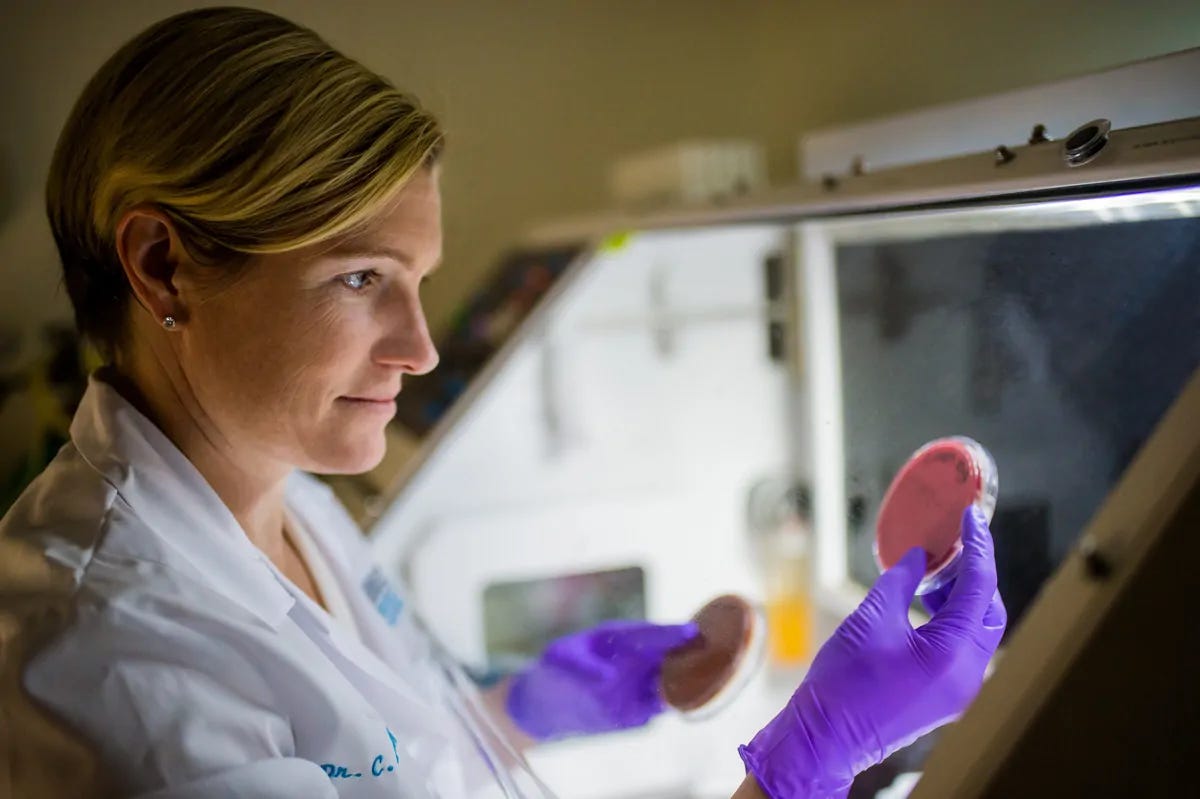Sci-Ed Update 302
Alternative grading evidence, vaginal microbiome, long COVID mechanisms, A-fib on the rise, manganese & memory in teens, sugar & brain decline, adjunct struggles, med ed should include Nazi past
Four key research results: A summary of some important research on alternative grading

Academic articles, books, and even blogs – like this one! – are often filled with personal anecdotes about alternative grading, both from instructors and students. And that’s not a bad thing: There’s a lot that can be learned from individual stories of alternative grading, especially when it comes to figuring out what works best in a given situation.
This might lead to the impression that there isn’t much research on alternative grading, which is anything but the case (see my bibliography, or Matt Townsley’s bibliography for starters). These articles include many studies, often small-scale, addressing a wide range of issues, types of classes, and types of grading.
When I speak about alternative grading and bring up research, I often find myself referring over and over to a few essential articles from those lists. These aren’t necessarily the studies with the largest n-values or the grandest research questions. Rather, they are results that directly and clearly address some of the most common concerns about alternative grading, or confirm important but otherwise anecdotal benefits. Today, I’ll summarize four key results related to feedback, test anxiety, cheating, and performance in later traditionally graded classes.
Read more→ AandP.info/36o
The Vaginal Microbiome is Finally Getting Recognized

Over the past decade, there has been an explosion of scientific research on the gut microbiome. Scientists have explored the role of this complex microbial community in just about every aspect of human health, including cancer, immune function, and even neurodegenerative disease.
By comparison, the vaginal microbiome has received very little attention, despite the prevalence of bacterial vaginosis (BV), which occurs when the vaginal microbiome shifts into a dysbiotic, or unhealthy, state. BV plagues approximately 30 percent of reproductive-age women in the United States; in some countries, more than 50 percent of women may be affected.1,2
While many people consider the pain, burning, itching, and strong odor characteristic of BV to be merely a nuisance, this condition can have enormous effects on patients’ lives. “People will tell you that BV has destroyed their sense of intimacy with their partner and that it makes them feel ashamed. It has really destroyed their sense of well being,” said Caroline Mitchell, a reproductive biologist at Massachusetts General Hospital.
However, the impacts of vaginal dysbiosis extend even further, with important health consequences not just for women, but for humanity as a whole. That’s because research indicates that the vaginal microbiome could influence the propagation of sexually transmitted infections (STIs), including chlamydia, gonorrhea, and human immunodeficiency virus (HIV).3 BV has also been linked to infertility and risk of preterm birth, which is itself associated with an increased risk of lifelong cardiovascular, respiratory, and neurodevelopmental conditions in the child. 4–7
“The vaginal microbiome, one could say, is probably the most important microbiome because none of us would be here without pregnancy and birth,” said Craig Cohen, a reproductive health researcher at the University of California, San Francisco.
Read more→ AandP.info/vt9
Scientists are beginning to understand how long COVID symptoms affect the brain
Many symptoms of long COVID are related to the brain. Now scientists are beginning to understand why brain fog, fatigue, and pain can linger for years after a person was infected.
Kevin Patton comment→ This is a short segment (with transcript) from a public radio spot by Ari Shapiro.
Read more→ AandP.info/pl5
With A-Fib on the Rise, Researchers Work to Fine-Tune Treatments

A stuttering heart. A fluttering heartbeat. A racing pulse. Through the ages, writers have reserved such phrases for the dramatic moments of their stories, when the main character is overcome with passionate love or overwhelmed by intense anger or fear.
Yet despite what centuries of literature may suggest, a change in heartbeat isn’t necessarily tied to a profound emotional shift. Sometimes, it is simply a physiological quirk that transforms the usual, evenly spaced thumps into an erratic pattern of beats that speed up and slow down of their own accord. And often, such chaotic beating is the result of a condition called atrial fibrillation.
It’s no exaggeration to say that atrial fibrillation is all around us, hiding in plain sight. It is the most common type of sustained, irregular heartbeat, and it is expected to become more common. In a 2013 paper in the American Journal of Cardiology, researchers estimated that U.S. cases would jump from 5.2 million in 2010 to 12.1 million in 2030. “Almost everybody knows somebody who has it,” Zimetbaum emphasizes.
Atrial fibrillation is so common that [Associate Professor of Medicine Usha] Tedrow regularly sees patients who first detect it with a heart rate monitor on their smartwatch or other wearable device — a screening strategy that she thinks could become broadly useful. “There are a lot of ongoing clinical trials that may demonstrate the benefits more, but for some patients, these devices really offer the opportunity to make a diagnosis in a way that we couldn’t before,” Tedrow says.
Yet despite the ubiquity of atrial fibrillation, there are still major knowledge gaps about its basic biology. In particular, scientists don’t know precisely what causes heart tissue to start spontaneously firing electrical impulses, and why it continues to do so over time. They also don’t know why it can be so hard to restore normal heart rhythm in some patients.
Read more→ AandP.info/v9c
High-Sugar Diets May Fuel Brain Decline

Research suggests a high-sugar diet, commonly associated with obesity, leads to insulin resistance in the brain and may heighten the risk of neurodegenerative diseases like Alzheimer’s.
The study reveals that this insulin resistance impairs glial cells’ ability to clear neuronal debris, a crucial process for preventing neurodegeneration.
By studying fruit flies, which share physiological similarities with humans, the team uncovered that a sugar-rich diet decreases the levels of the PI3k protein in glial cells and Draper protein in ensheathing glia, hindering their debris-clearing functions.
Key Facts:
Obesity-related high-sugar diets can cause insulin resistance in the brain, which was demonstrated to reduce the brain’s capacity to remove neuronal debris.
The study found that this resistance lowers PI3k and Draper protein levels in glial cells, directly impacting their debris-clearing abilities.
These findings connect diet-induced insulin resistance to an increased risk of neurodegenerative diseases, offering new insights for preventive therapies.
Read more→ AandP.info/6rf
Adjunct Professors Face a ‘Constant Struggle to Not Give Up,’ Report Says
Adjunct faculty members continue to teach in uncertain, challenging environments, often with no compensation for service work, no guarantee of employment beyond the term, and no assurance of academic freedom.
Those stressors have been exacerbated in recent years by pandemic-era virtual and hybrid learning, as well as legislative efforts to restrict faculty teaching and
That’s the message of a new report from the American Federation of Teachers on working conditions for contingent faculty members, who make up an estimated 68 percent of higher ed’s teaching work force.
The report is based on a survey conducted last year by the organization, which collected responses from more than 1,000 adjuncts at both public and private, two- and four-year institutions. It’s the third report in a series analyzing quality of work and life for professors off the tenure track; the first two were based on surveys conducted in 2019 and 2020.
Read more→ AandP.info/8z9
Medical education must include the field’s Nazi past, expert panel urges

All health care students worldwide should learn the history of medicine during the Nazi regime and the Holocaust, according to a report published Wednesday by The Lancet. The journal formed a commission in 2021 to explore how the lessons from that time could help improve medical education in the future. In its 50-page report, the commission highlights the stories of victims, perpetrators, collaborators, and resisters of Nazi crimes in the practice of medicine. These include the use of concentration camp prisoners in heinous medical experiments, widespread forced sterilizations, and “euthanasia” programs that murdered more than 200,000 people deemed mentally unfit, including children.
The report confronts the fact that the medical profession had one of the highest rates of Nazi party membership (more than half of Germany’s non-Jewish doctors joined the party) and also highlights doctors, midwives, and nurses who worked against the regime’s murderous practices. Among the report’s recommendations for future generations of medical personnel is the formation of an international professional organization focused on the issues and a digital library accessible in multiple languages to health care students around the world.
Read more→ AandP.info/pcd
Early Manganese Exposure Boosts Learning and Memory in Teens
New research reveals that manganese exposure in early life stages may enhance verbal learning and memory during adolescence.
The study, utilizing tooth manganese levels as biomarkers, indicates that prenatal exposure is linked to improved cognitive functions, while postnatal exposure shows no significant association.
This pioneering work underscores the nuanced role of manganese in neurodevelopment.
Key Facts:
Prenatal manganese exposure correlates with improved adolescent learning and memory.
Childhood manganese exposure contributes to better memory recall, but postnatal exposure doesn’t show cognitive benefits.
The study emphasizes the importance of exposure timing on the effects of manganese on brain development.
Read more→ AandP.info/vad






